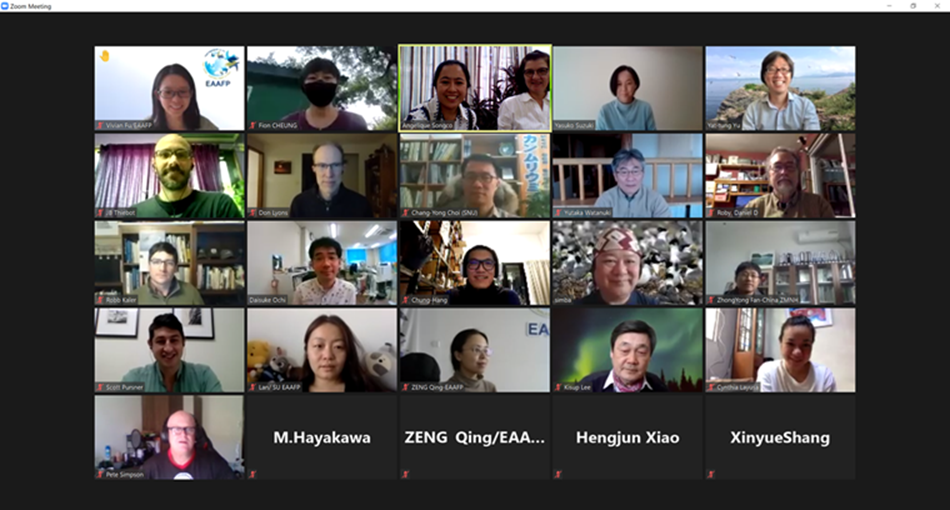
In conjunction with the Pacific Seabird Group Annual Meeting held virtually from 22 to 26 February, 2021, the Northeast Asia Seabird Conservation Committee (NEASCC) meeting, as one of the working committees, was organized on 22 February Pacific Standard Time. A total of 37 participants from USA, Japan, China, Hong Kong, Taiwan, Republic of Korea, the Philippines joined the meeting.
The meeting was kick-started and moderated by committee chairs, Daisuke Ochi from Fisheries Research and Education Agency, Japan and Yasuko Suzuki from BirdLife International. After a round of self-introduction of all participants, Yutaka Watanuki from Hokkaido University commenced the meeting with his presentation titled “Seabird sensitivity map for off-shore wind farms in Japan”. He shared the comprehensive mapping of density of seabird, survey efforts, protected areas and identified the sensitivity of seabirds to offshore wind farms through modeling and tracking data.
Simba Chan followed, who introduced “Recent updates on nationally protected seabirds in China and what does it mean to seabird conservation in the Pacific” to inform the committee that up to 27 seabird species were included in the 2021 updated List of Key Nationally protected species in China, which could enhance conservation effectiveness. He further suggested additional species of concern to be included to the list in the future. Remaining in the topics related to China, Feipeng Huang from Qingdao Birding Association presented “Introduction of the seabirds of Qingdao, Shandong Province, China” to share recent records of Critically Endangered Chinese Crested Terns, and recent studies and surveys of seabirds in Qingdao.
Moving on, there were two presentations about Chinese Crested Terns, one by Zhongyong Fan from Zhejiang Museum of Natural History on “The restoration of Chinese Crested Tern and conversation of seabirds in Zhejiang of China“ to update the results of the restoration programme with continuous success to reverse the population trend of the species. The team aims to develop the third restoration site in the future. Then Chung-Hang Hung from National Taiwan University gave his presentation “Conservation plans for Chinese Crested Tern and Little Tern in Taiwan”. In addition to the update of the Chinese Crested Tern conservation project, he also shared a recently initiated project to survey breeding colonies of Little Terns to evaluate the impact of renewable energy development on seabirds.
The meeting also invited Angelique Songco, a site manager of Tubbataha Reefs National Park in the Philippines to present “Seabird assessment of Tubbataha Reefs, Palawan, the Philippines in 2020”. As the last presenter, Suzuki shared “Pilot study of gillnet bycatch mitigation measures under controlled condition”. In 2020, she collaborated with Tokyo Sea Life Park and Atmosphere and Ocean Research Institute of the University of Tokyo to start an experimental study on gillnet bycatch mitigation techniques in a Common Murre and Tufted Puffin aviary with a dive pool at the aquarium. Data analysis of this study is planned in 2021.
During a discussion session, the participants raised ideas for future collaboration. Particularly, it was agreed that there is an urgent need for international collaboration to develop Asia’s regional sensitivity map for offshore wind farms. NEASCC agreed to form a sub-group for further discussion among interested individuals, with Jean-Baptiste Thiebot from National Institute of Polar Research, Japan and Watanuki to lead the sub-group. Before the end of the meeting, nomination of a new co-chair was proceeded. Ochi would step down after serving as a co-chair for several years, and Thiebot will step up as a new co-chair. Suzuki will continue to serve as a co-chair until NEASCC meeting in 2022.

Group photo of the NEASCC meeting © Angelique Songco
A follow-up meeting for the newly formed subgroup for “Asia’s regional sensitivity map for offshore wind farms and renewable energy facilities” was held on 31 March, 2021, facilitated by Thiebot. He also presented long-term tracking of seabirds over their annual cycle, across years and colonies, which enables to highlight key areas that are a priority for conservation. He illustrated above with his study of Rhinoceros Auklets by using miniaturized light-based geolocation loggers.
More information:
Know more about Pacific Seabird Group and Northeast Asia seabird conservation committee, click [here].
Learn more about EAAFP Seabird Working Group, click [here].





